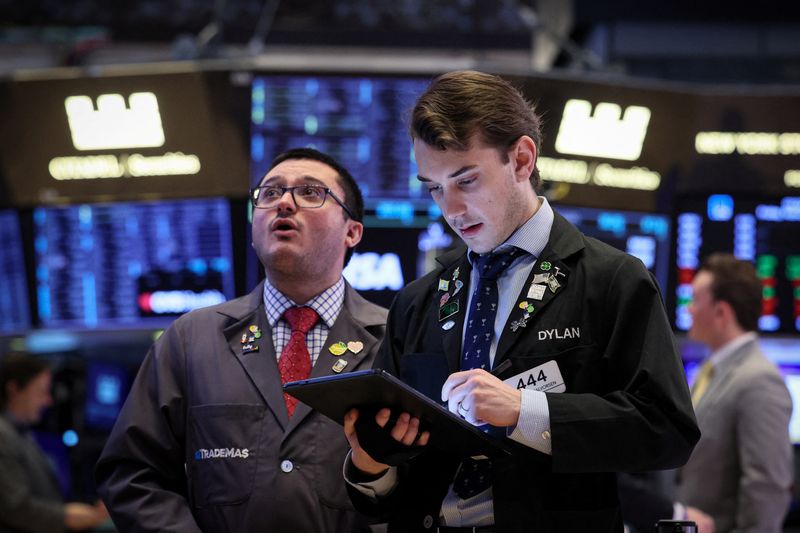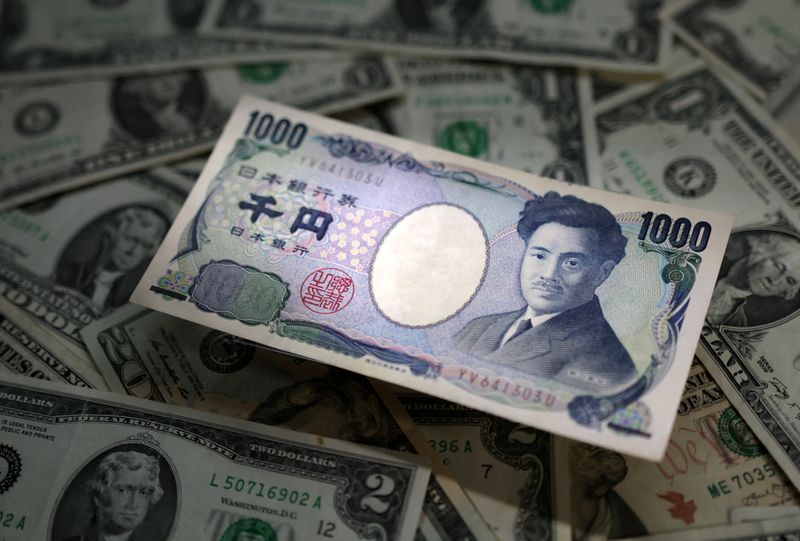Select Language

By Kevin Buckland
TOKYO (Reuters) -Most Asian stocks slid on Tuesday, led by sharp declines in Hong Kong as the start of China's week-long annual session of parliament disappointed investors with its lack of big ticket stimulus plans to prop up the struggling economy.
Equity markets in the region were already on the back foot following a retreat from record highs on Wall Street on Monday, amid signs the U.S. Federal Reserve is in no hurry to cut interest rates. U.S. stock futures also pointed lower, as did European futures.
Bitcoin continued its ascent to a fresh two-year peak of $68,828 that put it within spitting distance of an all-time high. Gold marked a record closing high of $2,114.99 on Monday and continued to hover around that level.
The Chinese government retained last year's target for economic growth of "around 5%" for this year, and announced plans to run a budget deficit of 3% of economic output, down from a revised 3.8% last year.
It also unveiled plans to issue 1 trillion yuan ($139 billion) in special ultra-long term treasury bonds, which are not included in the budget.
Mainland stocks reversed early losses with the blue-chip CSI 300 up about 0.45% by 0600 GMT, amid signs of suspected state-backed buying of some exchange-traded funds.
However, that failed to lift other markets in the region with Hong Kong's Hang Seng deepening earlier declines to 2.67%. MSCI's broadest index of Asia-Pacific shares outside Japan lost 1%.
The early announcements from China's NPC suggest "large fiscal stimulus is off the table for now," said James Kniveton, senior corporate FX dealer at Convera.
"Stability is still the overriding factor in Chinese policy making, and the announcements so far seem to conform to that philosophy."
Japan's Nikkei erased early losses in the afternoon session, but ended the day slightly down to miss out on a new record high close.
Meanwhile, alternative assets such as cryptocurrencies and bullion have been supported and equities sold following hawkish comments from Atlanta Fed President Raphael Bostic that there was no urgency to cut interest rates amid risks inflation stays above the central bank's 2% target.
Those remarks frayed nerves ahead of Fed Chair Jerome Powell's semi-annual testimony to Congress later in the week, as well as a deluge of key data on prices and jobs, culminating with Friday's non-farm payrolls report.
"There are signs of slight irrational exuberance and maybe a squeeze of long-suffering shorts in some markets," particularly bitcoin and gold, said Kyle Rodda, senior markets analyst at Capital.com.
"The moves have come despite only a minor shift in rates market pricing."
Odds for a U.S. rate reduction by the Fed's May meeting declined below 22% from 26% a day earlier, according to CME Group's (NASDAQ:CME) FedWatch Tool.
The dollar index, which measures the currency against six major peers, edged up 0.02% to 103.86. It eased 0.07% on Monday, as declines against rivals like the euro and sterling overshadowed gains against the yen.
The euro was flat at $1.0852, after advancing 0.14% on Monday, with the European Central Bank due to set policy on Thursday. Traders are convinced it will keep rates steady at the meeting, but futures imply an 88% probability that cuts will start in June.
Sterling was little changed at $1.2685, following a 0.3% rise at the start of the week, in the run-up to Wednesday's UK budget. Finance Minister Jeremy Hunt has been trying to dampenspeculation about big pre-election tax cuts.
Against the yen, the dollar was steady at 150.49, following Monday's 0.27% climb. The currency pair tends to be extremely sensitive to moves in long-term U.S. bonds, and benchmark 10-year Treasury yields bounced from 2-1/2-week lows overnight to sit at 4.21%.
Elsewhere, crude oil continued to tick lower, as demand headwinds counterbalanced a widely expected extension of voluntary output cuts through the middle of the year by the OPEC+ producer group. [O/R]
Brent futures were off 17 cents to $82.63 a barrel, while U.S. West Texas Intermediate (WTI) eased 25 cents to $78.49 a barrel.
($1 = 7.1975 yuan)

By Anant Chandak
BENGALURU (Reuters) - Activity in India's services sector continued to accelerate in February, albeit at a slightly slower pace, according to a business survey that also showed inflationary pressures were cooling.
Tuesday's survey injects a sense of optimism in the industry, the engine of economic growth and jobs, suggesting Asia's third largest economy will continue to grow at a world-beating pace this year after registering 8.4% last quarter.
The HSBC India Services Purchasing Managers' Index, compiled by S&P Global, fell to 60.6 last month from January's six-month high of 61.8 and confounding a preliminary reading for a rise to 62.0.
However, it has stayed above the 50-mark that separates growth from contraction since August 2021.
"India's services PMI suggests that the pace of expansion in the services sector eased in February from January," noted Ines Lam, economist at HSBC.
"Due to a slowdown in growth in new orders and output, services companies' outlook for future business activity, while remaining strongly positive, weakened slightly."
New business - a key gauge of demand - softened to a six month low but has been in expansionary territory for over two-and-a-half years and orders from abroad remained resilient.
However, the outlook for the coming 12 months was not as positive and business optimism was at its weakest since November. Hiring slowed and employment generation was barely in positive territory.
That said, firms got some relief from inflationary pressures with operating costs rising at the weakest pace since December, which was somewhat passed on to customers as prices charged rose at the slowest pace in two years.
India's retail inflation touched a three-month low in January and was expected to remain within the Reserve Bank of India's target range of 2%-6% over the coming months although it will be at least July before the central bank cuts borrowing costs, a recent Reuters poll found.
Despite India's manufacturing industry growing at the fastest pace in five months in February, the slower expansion in services activity brought the HSBC India Composite PMI Output Index lower to 60.6 in February from the previous month's 61.2.

By Neil Jerome Morales and Mikhail Flores
MANILA (Reuters) - Philippine annual inflation sped up for the first time in five months in February because of faster increases in food and transport costs, likely giving the central bank little reason to consider lowering interest rates.
The consumer price index (CPI) rose 3.4% in February from a year earlier, the statistics agency said on Tuesday, which was above the previous month's 2.8% and the market forecast of 3.1%, but still within the central bank's 2% to 4% target for the year.
But the central bank said inflation could overshoot its target range from the second quarter because of the impact of the El Nino weather phenomenon on farm production and as prior inflation was slower.
"The risks to the inflation outlook have receded but remain tilted toward the upside," the Bangko Sentral ng Pilipinas said in a statement.
One of the main culprits behind the February uptick was rising prices for rice. The inflation rate for the staple accelerated to 23.7% from last year, the fastest in 15 years, because of elevated rice prices in the world market and the effects of lower prior price increases.
Core inflation, which strips out volatile food and energy items in the consumer basket, eased to 3.6% versus the previous month's 3.8%.
The central bank, which last month kept its benchmark rate steady at 6.50% for a third straight meeting, said it "deems it appropriate to keep monetary policy settings unchanged in the near term." It meets next to review policy on April 4.
The central bank would likely keep rates at current levels for an extended period, ING Economist Nicholas Mapa said in a post on social media platform X.

By Matt Tracy
(Reuters) - Defaults among U.S. corporate junk debt issuers reached a post-pandemic high in February, JPMorgan said in a new research report.
Nine junk-rated borrowers either filed for Chapter 11 bankruptcy or missed their interest payments on a total of $5.97 billion in loans and bonds last month, JPMorgan noted.
Three other companies opted for a distressed exchange on a total $3.96 billion in loans and bonds, the report added.
February was only the second time in 11 months that the volume of defaults outweighed distressed exchanges.
Since the Federal Reserve began hiking interest rates in 2022, companies facing default have increasingly turned to out-of-court distressed exchanges, credit rating agency Moody's (NYSE:MCO) said in a recent report.
Last month's $9.9 billion in combined defaults and distressed exchanges surpassed 2023's monthly average of $7.2 billion, JPMorgan said. It was the highest combined volume of the two since $16.9 billion posted in April 2023.
Moody's and other ratings agencies anticipate the default rate among junk-rated issuers will rise this quarter before leveling out by the end of 2024.

BANGKOK (Reuters) - Thailand's economy is in a critical situation, the prime minister's chief of staff said on Monday, stressing a need for measures to tackle household debt, boost tourism and inject stimulus into the economy.
"Figures show we are not in good shape," Prommin Lertsuridej told reporters.
His remarks come as Prime Minister Srettha Thavisin's government pushes to revive Southeast Asia's second-biggest economy, which has suffered from weak exports and a slow recovery from the pandemic compared to regional peers.
The economy unexpectedly contracted in the fourth quarter of 2023 and policymakers have downgraded the growth outlook for this year, adding to pressure on the central bank to give in to the prime minister's near-daily demands for an interest rate cut.
"We are doing everything we can," Prominn said, referring to stimulus measures including visa-free tourism and policies to address household debt that is at a rate of 91% of gross domestic product.
He added the government's annual budget should be approved and ready to spend by next month.
The budget has been on hold since October due to a delay last year in forming a government.

By Liz Lee and Albee Zhang
BEIJING (Reuters) - China's Premier Li Qiang will not hold a press conference after the close of this year's annual parliamentary meeting, an official said on Monday, ending a tradition maintained for three decades.
Since 1993, China's premiers have met the media after the annual gathering of the National People's Congress (NPC), offering journalists, including the foreign press, a rare chance to ask questions in a typically wide-ranging news conference.
The decision was made because there would be more briefings by government ministers during the annual parliament meeting where senior cabinet officials will talk about issues on diplomacy, economy and people's livelihood, NPC spokesman Lou Qinjian told reporters on Monday.
The premier would not give media briefing at the conclusion of future NPCs, Lou added.
At the close of the annual parliament last year, Li sought to reassure the country's private sector in his first media conference as premier.

(Reuters) - NASA said on Friday it is shutting down a more than $2 billion project to test satellite servicing like fueling in space, citing higher costs and schedule delays.
The space agency said in October that the On-orbit Servicing, Assembly, and Manufacturing 1 (OSAM-1) project continues to face an increase in costs and is expected to exceed its $2.05 billion price tag and the December 2026 launch date.
For its decision to discontinue the project, NASA on Friday cited "continued technical, cost, and schedule challenges, and a broader community evolution away from refueling unprepared spacecraft, which has led to a lack of a committed partner".
Much of the project's cost growth and scheduling delays could be attributed to the "poor" performance of contractor Maxar, NASA said in October.
Maxar was previously contracted by NASA in 2019 to help build its Gateway platform in lunar orbit, a crucial outpost for America's first mission to relay astronauts to the moon.

(Reuters) -Credit ratings agency Fitch on Friday affirmed United States' long-term foreign currency sovereign credit rating at "AA+" with a "stable" outlook.
Fitch forecast the country's gross domestic product growth to slow in 2024, despite its economy proving resilient in the face of higher interest rates.
The U.S. economy grew by 2.5% in 2023, partly reflecting the renewed fiscal policy easing as highlighted by the large general government (GG) deficit in 2023.
Fitch estimated that the GG deficit had reached 8.8% of GDP in 2023 and forecast the 2024 GG deficit to narrow to 8% of GDP, on the back of escalating revenue growth, narrower spending, falling off of some large one-off spending on deposit insurance in 2023.
"The interest burden, however, will continue to grow given the higher debt burden and impact of higher rates," Fitch added.
According to the agency, the outcome of the upcoming November presidential and congressional elections will be important for policymaking and the ability to pass and implement legislation.
In November, peer Moody's (NYSE:MCO) lowered outlook on the country's credit rating to "negative", citing large fiscal deficits and a decline in debt affordability.

Investing.com -- It’s set to be a busy week in in markets with Friday’s U.S. jobs report, testimony by Federal Reserve Chairman Jerome Powell and a European Central Bank policy meeting the main highligts. Here’s what you need to know to start your week.
1. Nonfarm payrolls
Friday’s monthly jobs report will be keenly awaited with investors trying to gauge the timing of the first interest rate cut by the Federal Reserve, with bets currently targeting June amid hopes that the central bank can engineer a soft landing for the economy.
Signs of continued strength in the labor market could make it harder for investors to shrug off concerns about how a stronger-than-expected economy could reignite inflation if the Fed begins easing too soon.
Economists are expecting the economy to have added 190,000 jobs in February after January’s blowout 353,000 gain that was the largest in a year. The unemployment rate is expected to hold steady at 3.7%, while wage growth is expected to have moderated.
2. Powell testimony
Ahead of Friday’s jobs data, investors will get a chance to hear from Fed Chair Jerome Powell in his semiannual testimony on monetary policy before a House committee on Wednesday and a Senate panel on Thursday.
Powell is expected to reiterate that policymakers will stick to a cautious approach in deciding when to begin lowering interest rates given recent data pointing to strength in the economy and persistent price pressures.
Richmond Fed President Thomas Barkin said Friday it is too soon to predict when the central bank will be able to begin to cut its benchmark interest rate, as price pressures still exist in the U.S. economy.
3. Stock market rally
The Dow, the S&P 500 and the Nasdaq notched their fourth straight month of gains in February in a rally largely fueled by growth prospects related to AI, which has also lifted semiconductor names.
The S&P 500 and Nasdaq closed at record highs on Friday and the gains marked the second straight closing record for the Nasdaq, which also set an intraday record, surpassing its prior peak of 16,212.23 set in November 2021.
Markets have also been supported by indications that the economy remains resilient in the face of elevated interest rates.
"Because the economy is doing well and because inflation remains a bit sticky, the Fed will be slower to lower interest rates," Sam Stovall, chief investment strategist at CFRA Research in New York told Reuters.
"But that's good because then we're gradually coming off of the higher interest rate cycle and we're not in need of cutting rates aggressively."
4. ECB decision
The ECB is to meet on Thursday and no policy changes are expected, with investors instead waiting to see whether officials will repeat that it's too early to discuss rate cuts.
The ECB has pushed back on rate cut talk, with officials saying they need to see more evidence that inflation is on track to return to its 2% target, but markets are still expecting Frankfurt to begin cutting rates later this year with a first move expected in June.
Eurozone inflation data on Friday appeared to support the ECB’s cautious stance. Consumer price inflation slowed less than expected in February, while underlying inflation also moderated at a slower than expected pace.
The ECB's big worry is that wage inflation is still too high and risks stoking price pressures for longer.
5. Oil prices
Oil prices rose on Friday and posted weekly gains as traders awaited an OPEC+ decision on supply agreements for the second quarter while also weighing fresh U.S., European and Chinese economic data.
For the week, Brent added around 2.4% following the switch in contract months, while Crude Oil WTI Futures gained more than 4.5%.
A decision by the Organization of the Petroleum Exporting Countries on extending output cuts is expected during the coming week, according to reports, with individual countries expected to announce their decisions.
"The expectation that OPEC+ is going to continue with their voluntary production cuts well into the second quarter of 2024 is the main focus on the market," Andrew Lipow, president of Lipow Oil Associates told Reuters.
Geopolitical tensions in the Red Sea also look set to continue to underpin prices.
--Reuters contributed to this report

By Tom Westbrook
SINGAPORE (Reuters) -The dollar tracked toward monthly gains on Thursday ahead of highly-anticipated inflation data that could ruffle the interest rate outlook, while the sliding yen found a footing after a policymaker hinted at the need to exit ultra-easy policies.
Bitcoin was on the charge, topping $63,000 early in the European morning for a gain of nearly 50% in February. The monthly rise is the largest since December 2020, and a record high above $69,000 is within sight. It was last at $63,051.
The yen and fellow safe-haven Swiss franc are the worst performing G10 currencies against the dollar this month as investors have sought out riskier assets and as bets on U.S. interest rate cuts have been dialled back - lifting the dollar.
The yen last traded at 149.87 to the dollar, down about 2% on the month. It was almost 0.6% higher on the day after Bank of Japan board member Hajime Takata said he felt there were finally prospects for achieving the bank's 2% inflation target, paving the way to leave behind negative rates and yield caps.
The yen is down more than 2% on the euro this month and made nine-year lows on the Australian and New Zealand dollars as investors pick up income by borrowing yen at rates near zero and selling it against currencies where interest rates are higher.
"Takata's remarks should add to conviction that an earlier than expected hike at March meeting should not be ruled out," said Christopher Wong, currency strategist at OCBC.
"With JPY shorts at record high, unwinding of shorts should see JPY bears run for cover."
The euro was steady at $1.0835 and largely flat for the month, as was sterling at $1.2665. The Australian and New Zealand dollars have lost ground in February as expectations firmed that rate hikes have finished down under.
The New Zealand dollar in particular nursed losses at $0.6105, having dropped 1.2% on the dollar a day ago when the central bank held rates and surprised markets with a downward tweak to its rates forecast. The Australian dollar ticked 0.3% higher to $0.6516 on Thursday for a monthly drop of 0.8%.
The Federal Reserve's favoured measure of inflation - the core personal consumption expenditures (PCE) price index - is due later on Thursday and forecasts are for a rise of 0.4%.
It was not long ago investors were hoping for just a 0.2% increase but high readings on consumer and producer prices suggest the risk is for a result as high as 0.5%.
"A stronger than expected PCE deflator can cause markets to reduce pricing for a May rate cut even further, supporting U.S. dollar," said Commonwealth Bank of Australia (OTC:CMWAY) currency strategist Kristina Clifton.
Markets price about a 20% chance of a Fed easing in May, and have pushed out the likely timing of a cut to June. Futures imply a little more than three 25 basis point cuts this year, compared to five at the start of the month.
The U.S. dollar index was little changed at 103.86.

